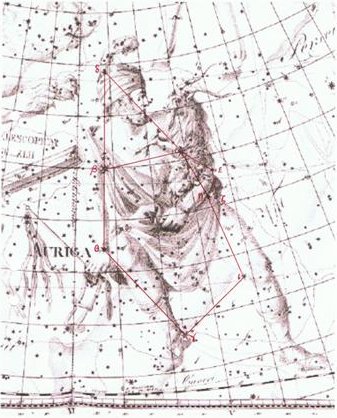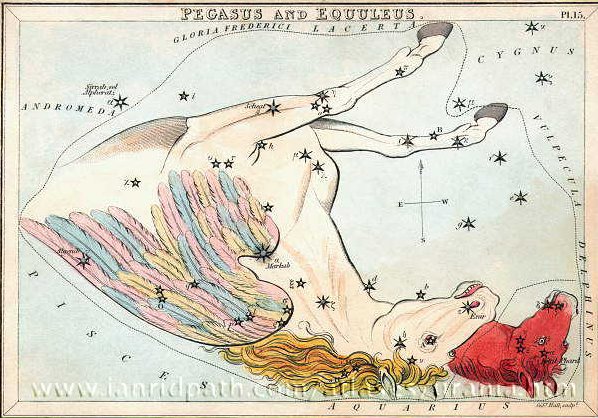4. Now we are ready to once again consider what Allen has written:
... ι, 3.1, was Al Tizini's Al Ka'b dhi'l 'Inān, which other authors gave to γ; and Kazwini included it with the latter in his Al Tawābi' al 'Ayyūk... ... γ, 2.1, brilliant white, was Al Ka'b dhi'l 'Inān, the Head of the Rein-holder, of Arabian astronomy, so showing its location in the figure of Auriga. From the earliest days of descriptive astronomy it has been identical with the star al Nath, the β of Taurus at the extremity of the right horn, and Aratos so mentioned it. Vitruvius, however, said that it was Aurigae Manus, because the Charioteer was supposed to hold it in his hand, which would imply a very different drawing from that of Rome, Greece, and our own; and Father Hell, in 1769, correctly had this expression for the star θ.
The later Arabian astronomers also considered it in Taurus by designating it as Al Karn al Thaur al Shamāliyyah, the Norhern Horn of the Bull; but Kazwini adhered to Auriga by giving 'the two in the ankles' as Al Tawābi' al 'Ayyūk, the Goat's Attendants, Ideler identifying these with γ and ι ...
We should notice how Ideler has identified the pair of feet with twins. I think this is significant, because twins there were plenty of in the sky.
But the right foot does not seem to signify the beginning (spring etc) and the left foot the end (autumn, etc), because Toliman has his right foot in front and the True Shepherd of Anu his left foot in front. The case of Auriga may be different, though, because he is not seen from the side (as in the Babylonian zodiac).
Not only do we have Castor and Pollux (plus the Little Twins in the Babylonian zodiac) but we should also remember the Two Horsemen (γ and β Arietis, Mesarthim and Sheratan)
a constellation said to be in the form of a Horse's Head.
This, in turn, seems to connect us to the pair of twin horse heads representing Pegasus:
The Sacred Jawbone might come from one of these horses. And perhaps there may be a connection with Te Piringa Aniva, because Piriga could allude to Pipiri (a name for Castor): ... According to Ellis, Castor and Pollux are known as Pipiri and Rehua in the Society Islands ... Anyhow Theemin might be located here (where the people are sticking close together):
The expression kai viri kai viri (said by Ira when he saw the 3 islets outside the southwestern corner of Easter Island) could allude to a similar kai piri kai piri for Te Piringa Aniva. My guess is a long shot, but there seems to be some relationship between Te Piringa Aniva and piri: Kai piri, kai piri, ia anirá i-piri-mai-ai te me'e rakerake, such a bad thing had never happened to me before! Auriga is a constellation in the 6th hour and we will therefore stop here and save the further discussions until later. Speculations as to the meaning of the name Hassaleh will also have to wait until then. |
||||||||||||||||||||||




